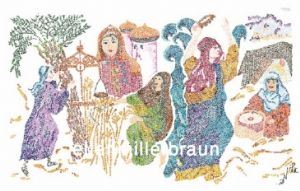| |

|

|
WOMEN OF VALOR
Drawing
Size: 11.6 x 16.5
44.95 USD
Description:
Woman of Valor (Proverbs 31:10-31)
This passage created in micro calligraphy is a hymn to the perfect wife, the backbone of the home. Jewish tradition sees this chapter allegorically, as a reference to G-d's Spirit, the Sabbath, the Torah, the soul, and wisdom. Choosing the Jewish woman as the image through which to describe such moving spiritual concepts is a profound tribute to her.
The Hebrew word for "valor" -- chayil -- as it is used in Scripture, has many interchangeable definitions: accomplishment, strength, organized military force, skill, general competence, devoutness, righteousness and wealth. It implies the existence of those characteristics that are needed to accomplish whatever task is at hand.
Ellen Miller Braun chose each of the five Biblical women forming this beautiful and unique panorama because they personify the ideal of the "Woman of Valor." Each of these women is a constant source of inspiration for women, then and now:
The Matriarch Sarah
The cloud of G-d's Presence casts an everlasting cooling shade over the Matriarch Sarah, as she sits working before her desert tent (Genesis 24:67, Rashi). Sarah sits grinding wheat for bread to feed the always-welcome guest (Genesis 18:2-7). Over her shoulder, the Sabbath candles, miraculously staying lit from one Sabbath lighting to the next (Genesis 24:67, Rashi), blaze forth the guiding light of the righteous.
Miriam the Prophetess
Miriam, Moses' sister, bursts forth in song and dance, guiding and leading the women of Israel in praise and thanks to G-d after successfully crossing the Red Sea, depicted by the column of water. The blue, pure water also symbolizes Miriam's righteousness. As long as she was alive, there was always drinking water flowing from the rock during the Jews' forty-year journey in the wilderness. (Exodus 15:20-22, Numbers 20:1-2).
Ruth, the Mother of Royalty
Ruth, modest yet strong, collects wheat to feed herself and impoverished mother-in-law, Naomi. Because of her modesty and righteousness, G-d chooses Ruth to be the matriarch of the Davidic line. Ruth's devoutness is inherited by her great grandson, King David, who with G-d's help will be fully manifest in their royal descendant, the Messiah (The Book of Ruth).
Queen Esther
This modest Jewish maiden becomes the Queen of Persia, and is therefore depicted here in traditional Persian costume.Together with the hidden hand of G-d, Esther leads her people from certain death to victory over their enemies. Thanks to her influence and competence, the chosen People become the moral leaders of their time.
Queen Esther had two names: Esther, her Persian name, and Hadassah, her Hebrew name. Though the name Esther is Persian, it is phonetically similar to the Hebrew word for "hidden" -- hester. Its significance in the story of Purim is that, in it, the hand of G-d was "hidden." Unlike other times when the Jews were delivered from their enemies, there were no overt miracles. G-d's involvement was manifested in hidden and earthly ways.
Hadassah is the feminized version of the word for "myrtle" --hadas. The myrtle leaf is shaped like an eye - representing G-d's watchful eye over Queen Esther and over his chosen people (The Book of Esther).
Deborah, Prophetess and Judge
Both prophetess and judge, Deborah holds a unique place in Biblical history. She surges forward, ready to join general Barak on the battlefield. Deborah is depicted here before her palm tree, where she sat in judgment, holding a balance, the symbol of her title as judge. She thrusts the judge's scales towards the heavens, beseeching G-d to guide her in her honorable decisions (Judges 4:4-14; 5:1-31).
Limited Edition Reproductions Giclée on Fine Art Textured Paper available upon request
|
|

|
|